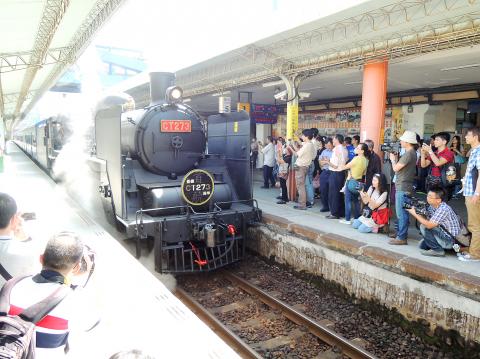A CT273-model steam locomotive, which had not seen active duty for 35 years carried passengers again yesterday as part of celebrations of the 127th anniversary of the founding of the precursor to the Taiwan Railways Administration (TRA).
With the whistle blowing and white smoke puffing out of its smokestack, the “Queen of the Steam Locomotives,” led a four-carriage train into the Changhwa Railway Station at 9am. Passengers and railway enthusiasts on the platform captured the moment on their cameras and mobile phones.
The 240 seats on the train for a trip between Changhwa and Ershui (二水) quickly sold out when they went on sale online last month.

Photo: Wu Wei-kung, Taipei Times
Driver Liu Ken-yueh (劉耿岳) said the train was powered by the steam generated by burning coal, adding that the coal burner was right next to the driver.
“The temperature was quite high, and you really have to be able to bear it in the summertime,” Liu said, his clothes drenched in sweat. “Compared with electrical-powered trains, operating a steam train consumes a lot more of your strength.”
The locomotive was manufactured by Kawasaki Heavy Industries in 1943. It was used for the trains running between Taipei and Kaohsiung, and had a top speed of 85kph, making it the fastest train in service at the time.
The TRA stopped using the locomotive in 1979 and removed it from active duty in 1984.
In 1993, the Taiwan Folk Village (台灣民俗村) leased the locomotive to put it on display in the park. However, it failed to return the locomotive after its lease expired in 2008.
The TRA recovered the locomotive from the park in 2010 and placed it in the fan-shaped train depot in Changhwa.
Taipei Depot director Hong Chin-hsing (洪進興) said the locomotive was in a bad shape when the agency recovered it.
“Many of parts were rusty, and we had to tear down the locomotive to repair it,” Hong said. “Some of the parts were beyond repair and we had to redo them. The restoration of CT-273 was the most complicated and difficult task we have done.”
The TRA spent a little over two years restoring the locomotive so that it could become operational again, inviting retired technician Liu Shu-ken (劉樹根), 81, to supervise the restoration work, Hong said.
Liu has also helped restore CK124 and CK101-model locomotives.
The retiree stood with the drivers in the driver’s cabin yesterday to ensure that the locomotive was operating correctly.
The rare opportunity to see a steam locomotive in action drew many railway fans, including 11-year-old Yang Hao-yu (楊皓宇) and his family.
“I may not have the chance to board the train again if I miss today,” Yang said.
This year marks the 127th anniversary of the start of construction of a railway line between Keelung and Taipei in 1887. The line was extended during Japanese colonial rule by the Ministry of Taiwan Railway between Keelung and present-day Greater Kaohsiung, with construction finishing in April 1908.
The TRA was established in 1945 following the end of World War II and the end of the Japanese colonial era.
Meanwhile, a TRA employee in Hualian, Yang Chao-shun (楊朝順), was named an exemplary employee for his record of not taking a single day of leave — even for illness — in 24 years.
He has coordinated train times and operated switch machines and control signals at Heren Station, a cargo shipment station, since he joined the TRA in 1989.
Heren has the highest cargo transport volume of any TRA station at 13,000 tonnes a day, according to Hualien operations section boss Chang Chien-li (張建曆), who said the station has suffered from a lack of personnel on top of its heavy workload.
“Staff at the station have not had time for breaks, but Yang Chao-shun has not ever asked for leave, not even for one day,” Chang said.
Additional reporting by staff writer and CNA

The brilliant blue waters, thick foliage and bucolic atmosphere on this seemingly idyllic archipelago deep in the Pacific Ocean belie the key role it now plays in a titanic geopolitical struggle. Palau is again on the front line as China, and the US and its allies prepare their forces in an intensifying contest for control over the Asia-Pacific region. The democratic nation of just 17,000 people hosts US-controlled airstrips and soon-to-be-completed radar installations that the US military describes as “critical” to monitoring vast swathes of water and airspace. It is also a key piece of the second island chain, a string of

A magnitude 5.9 earthquake that struck about 33km off the coast of Hualien City was the "main shock" in a series of quakes in the area, with aftershocks expected over the next three days, the Central Weather Administration (CWA) said yesterday. Prior to the magnitude 5.9 quake shaking most of Taiwan at 6:53pm yesterday, six other earthquakes stronger than a magnitude of 4, starting with a magnitude 5.5 quake at 6:09pm, occurred in the area. CWA Seismological Center Director Wu Chien-fu (吳健富) confirmed that the quakes were all part of the same series and that the magnitude 5.5 temblor was

Taiwan will now have four additional national holidays after the Legislative Yuan passed an amendment today, which also made Labor Day a national holiday for all sectors. The Chinese Nationalist Party (KMT) and Taiwan People’s Party (TPP) used their majority in the Legislative Yuan to pass the amendment to the Act on Implementing Memorial Days and State Holidays (紀念日及節日實施辦法), which the parties jointly proposed, in its third and final reading today. The legislature passed the bill to amend the act, which is currently enforced administratively, raising it to the legal level. The new legislation recognizes Confucius’ birthday on Sept. 28, the

The Central Weather Administration has issued a heat alert for southeastern Taiwan, warning of temperatures as high as 36°C today, while alerting some coastal areas of strong winds later in the day. Kaohsiung’s Neimen District (內門) and Pingtung County’s Neipu Township (內埔) are under an orange heat alert, which warns of temperatures as high as 36°C for three consecutive days, the CWA said, citing southwest winds. The heat would also extend to Tainan’s Nansi (楠西) and Yujing (玉井) districts, as well as Pingtung’s Gaoshu (高樹), Yanpu (鹽埔) and Majia (瑪家) townships, it said, forecasting highs of up to 36°C in those areas